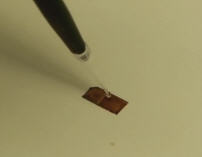New Material Coating Technology Mimics Nature’s Lotus Effect

Ever stop to consider why lotus plant leaves always look clean? The hydrophobic – water repelling – characteristic of the leaf, termed the “Lotus effect,” helps the plant survive in muddy swamps, repelling dirt and producing beautiful flowers.
Of late, engineers have been paying more and more attention to nature’s efficiencies, such as the Lotus effect, and studying its behavior in order to make advances in technology. As one example, learning more about swarming schools of fish is aiding in the development of unmanned underwater vehicles. Other researchers are observing the extraordinary navigational abilities of bats that might lead to new ways to reconfigure aviation highways in the skies.
Ranga Pitchumani , professor of mechanical engineering at Virginia Tech and currently on an invitational assignment as the chief scientist and director of the Concentrating Solar Power and Systems Integration programs of the U.S. Department of Energy’s SunShot Initiative www.solar.energy.gov, would like to see more efficiencies and clever designs in technology. His work reflects this philosophy.
His recent development of a type of coating for materials that has little to no affinity for water emulates the Lotus effect. Commonplace material coatings are as simple as paints and varnishes. More sophisticated coatings might be used for resistance to corrosion, fire, or explosives.
The American Chemical Society recognized the impact of the work of Pitchumani and Atieh Haghdoost, a recent doctoral graduate from Pitchumani’s Advanced Materials and Technologies Laboratory (www.me.vt.edu/amtl), featuring their research on the cover of its April 15 issue of the publication Langmuir, a highly-cited, peer reviewed journal. The article can be found at: http://pubs.acs.org/doi/abs/10.1021/la403509d, which includes a video demonstration of the coating
Using a two-step technique, “We produced a low-cost and simple approach for coating metallic surfaces with an enduring superhydrophobic (strong water repellant) film of copper,” Pitchumani explained. Copper allows for high heat and electrical conductivity, and is the material of choice in many engineering applications such as heat exchangers and electronic circuit boards.
Numerous methods currently exist to produce coating surfaces that for all practical purposes do not get wet as the water droplets run off the material. A few examples are: spraying; self-assembly where molecules spontaneously organize themselves into a structure; and laser etching.
But Pitchumani and Haghdoost explained their method “differs in that their two-step process is used to directly make superhydrophobic copper coatings without the more costly need for an additional layer of a low surface energy material.”
The two-step process uses a common coating technique called electrodeposition. Again, they have a distinction – the difference from previous manufacturing practices is that Pitchumani and Haghdoost do not use a template that can adversely affect the texture of the coating that is deposited on the surface of the material or substrate. Their template-free process allows the coating material to be made of the same material as the substrate, thereby preserving its thermal and electrical properties.
The possibilities for the technology are huge. The coatings can minimize or eliminate “fouling” – dirt and grime accumulation – in heat exchangers, reduce pressure drop in flow through tubes, provide improved corrosion resistance, and mitigate creep failure in electronic printed circuit board applications. They currently have an international patent pending (PCT/US2014/016312), that was filed through the Virginia Tech Intellectual Property office.
In the future, they hope to expand the nature-inspired innovation to materials other than copper.
Media Contact
All latest news from the category: Process Engineering
This special field revolves around processes for modifying material properties (milling, cooling), composition (filtration, distillation) and type (oxidation, hydration).
Valuable information is available on a broad range of technologies including material separation, laser processes, measuring techniques and robot engineering in addition to testing methods and coating and materials analysis processes.
Newest articles

Superradiant atoms could push the boundaries of how precisely time can be measured
Superradiant atoms can help us measure time more precisely than ever. In a new study, researchers from the University of Copenhagen present a new method for measuring the time interval,…

Ion thermoelectric conversion devices for near room temperature
The electrode sheet of the thermoelectric device consists of ionic hydrogel, which is sandwiched between the electrodes to form, and the Prussian blue on the electrode undergoes a redox reaction…

Zap Energy achieves 37-million-degree temperatures in a compact device
New publication reports record electron temperatures for a small-scale, sheared-flow-stabilized Z-pinch fusion device. In the nine decades since humans first produced fusion reactions, only a few fusion technologies have demonstrated…





















